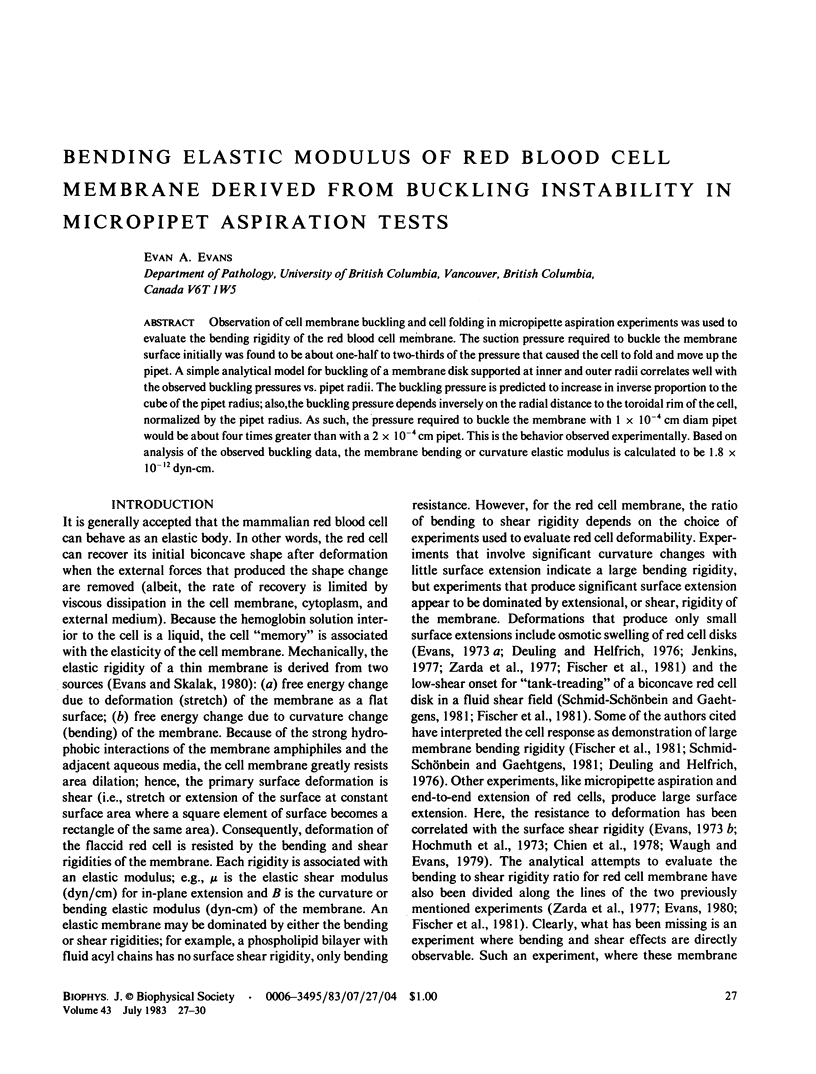Abstract
Observation of cell membrane buckling and cell folding in micropipette aspiration experiments was used to evaluate the bending rigidity of the red blood cell membrane. The suction pressure required to buckle the membrane surface initially was found to be about one-half to two-thirds of the pressure that caused the cell to fold and move up the pipet. A simple analytical model for buckling of a membrane disk supported at inner and outer radii correlates well with the observed buckling pressures vs. pipet radii. The buckling pressure is predicted to increase in inverse proportion to the cube of the pipet radius; also, the buckling pressure depends inversely on the radial distance to the toroidal rim of the cell, normalized by the pipet radius. As such, the pressure required to buckle the membrane with 1 X 10(-4) cm diam pipet would be about four times greater than with a 2 X 10(-4) cm pipet. This is the behavior observed experimentally. Based on analysis of the observed buckling data, the membrane bending or curvature elastic modulus is calculated to be 1.8 X 10(-12) dyn-cm.
Full text
PDF



Images in this article
Selected References
These references are in PubMed. This may not be the complete list of references from this article.
- Chien S., Sung K. L., Skalak R., Usami S., Tözeren A. Theoretical and experimental studies on viscoelastic properties of erythrocyte membrane. Biophys J. 1978 Nov;24(2):463–487. doi: 10.1016/S0006-3495(78)85395-8. [DOI] [PMC free article] [PubMed] [Google Scholar]
- Deuling H. J., Helfrich W. Red blood cell shapes as explained on the basis of curvature elasticity. Biophys J. 1976 Aug;16(8):861–868. doi: 10.1016/S0006-3495(76)85736-0. [DOI] [PMC free article] [PubMed] [Google Scholar]
- Evans E. A. A new material concept for the red cell membrane. Biophys J. 1973 Sep;13(9):926–940. doi: 10.1016/S0006-3495(73)86035-7. [DOI] [PMC free article] [PubMed] [Google Scholar]
- Evans E. A. Minimum energy analysis of membrane deformation applied to pipet aspiration and surface adhesion of red blood cells. Biophys J. 1980 May;30(2):265–284. doi: 10.1016/S0006-3495(80)85093-4. [DOI] [PMC free article] [PubMed] [Google Scholar]
- Evans E. A. New membrane concept applied to the analysis of fluid shear- and micropipette-deformed red blood cells. Biophys J. 1973 Sep;13(9):941–954. doi: 10.1016/S0006-3495(73)86036-9. [DOI] [PMC free article] [PubMed] [Google Scholar]
- Fischer T. M., Haest C. W., Stöhr-Liesen M., Schmid-Schönbein H., Skalak R. The stress-free shape of the red blood cell membrane. Biophys J. 1981 Jun;34(3):409–422. doi: 10.1016/S0006-3495(81)84859-X. [DOI] [PMC free article] [PubMed] [Google Scholar]
- Hochmuth R. M., Mohandas N., Blackshear P. L., Jr Measurement of the elastic modulus for red cell membrane using a fluid mechanical technique. Biophys J. 1973 Aug;13(8):747–762. doi: 10.1016/S0006-3495(73)86021-7. [DOI] [PMC free article] [PubMed] [Google Scholar]
- Jenkins J. T. Static equilibrium configurations of a model red blood cell. J Math Biol. 1977 May 23;4(2):149–169. doi: 10.1007/BF00275981. [DOI] [PubMed] [Google Scholar]
- Schmid-Schönbein H., Gaehtgens P. What is red cell deformability? Scand J Clin Lab Invest Suppl. 1981;156:13–26. doi: 10.3109/00365518109097425. [DOI] [PubMed] [Google Scholar]
- Waugh R., Evans E. A. Thermoelasticity of red blood cell membrane. Biophys J. 1979 Apr;26(1):115–131. doi: 10.1016/S0006-3495(79)85239-X. [DOI] [PMC free article] [PubMed] [Google Scholar]
- Zarda P. R., Chien S., Skalak R. Elastic deformations of red blood cells. J Biomech. 1977;10(4):211–221. doi: 10.1016/0021-9290(77)90044-6. [DOI] [PubMed] [Google Scholar]




